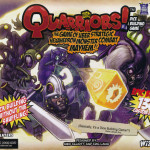
Quest into the wilds and capture your quarry. Build a custom collection of curious creatures to do your bidding and attack your opponents. Emerge victorious and gain glory for yourself and your empress. And do it all while rolling tons and tons of dice.
Quarriors takes the deck building strategy of Dominion and ups the ante. Instead of collecting cards to build out your deck, you will be building a collection of dice, each with their own unique and variable abilities. But will you be able to build a better collection than your opponents? And will the luck of the dice lead you to glorious victory, or ignoble defeat?
Components
The game consists of a number of cards that describe the dice, a scorecard and markers to track glory (this game’s victory points), and a lot of dice.
The cards come in three categories: basic cards, spells, and creatures. All three of the basic cards go on the table for every game, but each game will only have three of the spell cards and seven of the creature cards. Each card has a picture of the spell or creature that its matching dice represent, a description of that spell or creature’s powers and abilities, and a chart of the different faces available on the dice. Each creature and spell class has multiple cards associated with it with slightly different powers, and only card of that type can be in play each game. That means that even if you end up with a Quake Dragon in two games in a row you will likely at least have a different Quake Dragon, and it will play differently even with the same dice.
Which brings us to the dice themselves. With only a couple of exceptions each creature and spell type in the game has exactly five dice that go along with it. Each set of dice has a different color and sometimes style to attempt to match the creature or spell that they represent. For example, the Primordial Ooze dice are a translucent green, while the aforementioned Quake Dragon is a deep red, flecked with grey. Each also has its own unique symbol on several of the faces, representing that creature or spell. They will all also have the quiddity symbol on some of the faces, representing the currency of the game.
For creatures each face represents a slightly different version of the creature, either with different strengths or with additional abilities. The strength is represented with a power rating in the upper right corner of the die, and a toughness in the lower right. They also have a level in the upper left that will determine how much the creature will cost to put into play, should you roll that face. Special abilities are represented with a burst symbol that will sometimes appear in the lower left. The matching card will sometimes list additional effects that only happen when the burst is visible.
The cards are nicely laid out, and the artwork is usually fairly enticing. The names of the various creatures and spells can take some getting used to, as the game as a whole has a strong lean towards the overly punny. Depending on your sense of humor that can be an advantage or a disadvantage. The quality of the dice themselves is usually fairly good, but seems to slip quite as you get into the later expansions, having issues with printing on the faces, or the occasional misshapen die.
Game Play
The game play in Quarriors is actually fairly straightforward, with a couple of minor hiccups. Each player will draw dice out of their bag, roll them, and then start making choices about what they will do based on the result of the rolls. Any spell dice that come up with their symbols become instantly ready to cast, any creatures rolled can be summoned for a cost depending on how strong of a version you rolled, and any quiddity rolled goes into a temporary pool that can be used for that turn. There are a couple of special symbols as well, things that will let players re-roll dice or draw more dice from their bag, but that covers the basics of it.
Once their selections are complete if any creatures are summoned they are set out against any creatures their opponents may have, at which point it becomes a simple numbers game, your strength versus the opponents toughness, and they will need to kill off as many of their creatures as necessary to ward off your attack.
Once that is complete the deck-building, or pool building, portion of the game comes into play. The player is allowed to use any remaining quiddity to capture a die from “the wilds”, the selection of dice in the middle of the table. If you aren’t familiar with deck building, see my Dominion review, it follows a similar strategy here. The dice that are available in each game will vary, either through a random draw or through card drafting, so the optimal strategy on what to buy will change from game to game based on what is available, what you can afford with your current roll, and what your opponents are picking up.
If a player has creatures that survive to the beginning of their next turn, making it through each of their opponents attacks, then those creatures will score and earn that player glory points, a chance to cull their collection, and occasionally earn other benefits depending on which creature scored.
Later expansions introduced additional gameplay mechanics, such as locking dice that stick around for multiple turns, corrupted quiddity that can actually impede a players progress, and alternate play rules like the ability to purchase two dice in a turn instead of one, or the requirement to cull the creature that scored. Each addition alters the basic strategy of the game, assuming the mechanic actually comes up when cards are being selected.
Theme
The theming of the game is fun, and consistent across the majority of the cards, even if it is fairly simple. The game has a slightly campy fantasy feel to it, and in its own way is creating a world with each of the creatures that are made available. A weird, weird world. The story of Quarriors is advanced with each new expansion, but manages to remain more or less consistent as each new set comes out.
The basic idea behind the game’s theme, that you are a wizard warrior collecting the wild creatures of the land to do battle for you, plays out nicely with the actual mechanics of the game, which is nice. It does get a bit questionable when you get to certain creatures, for example the idea that you are sending out a couple of enslaved knights and a clergy man to kill a dragon, but it holds up if you don’t think too hard about it.
Replay and Expansion
Each game of Quarriors has a lot of room for variation. The types of creatures and spells that are available will shift from game to game, and there are multiple versions of each spell and creature as well, so even with the same dice in play the actual impact of those dice on the game will be different. Aside from that you also have the inherent randomness of the dice themselves to contend with, as well as the random draw of the dice from the bags, which will introduce a wide swing in the results of any given strategy, or the ability to even enact that strategy.
Even so the base game only comes with a handful of different creatures and spells, so if you play a lot you will start to see the same combinations come up over and over again. Fortunately there are multiple expansions available for the game that introduce a wide variety of new dice, and an exponential number of new possible game combinations. These expansions also introduce new mechanics into the game, giving more variety.
The biggest problems with the expansions so far is that the new mechanics they introduce have a tendency to get watered down and lost very quickly when they are used in conjunction with the other sets, as you will usually need to play primarily with the cards from that expansion for the new mechanics to even have an impact. This can have the unfortunate side effect of limiting the valid combinations of cards that can be used in a game, as some of these creatures become nearly useless without other creatures from the same expansion.
Final Thoughts
Quarriors can be a lot of fun, and can serve as a decent light strategy game as well as a dice rolling romp. There’s just something about rolling a whole fist full of dice to see what comes up. There are certainly choices to be made in the game, especially with the advanced rules introduced with the expansions, and skill and strategy can make a big difference. With that said there is also a lot of randomness to this game, from the initial set up to the dice draw and the roll, which means that a veteran player’s best played strategy can still fail to defeat the total newbie. Some people will love that possibility, others will loath it.
The game is not terribly long, but certainly has the potential to be dragged out depending a lot of the types of players in the game, as well as which rule sets are being played, and can be prone to analysis paralysis leading to long turns. The random factor can also lead to round after round going by with no points scored, drawing the game out. For some people the game may not have enough depth to warrant this extra play time, others will appreciate seeing their strategy come to fruition over that time. Your milage may vary.

Quarriors by Mike Elliot and Eric M. Lang
Published by WizKids Games
